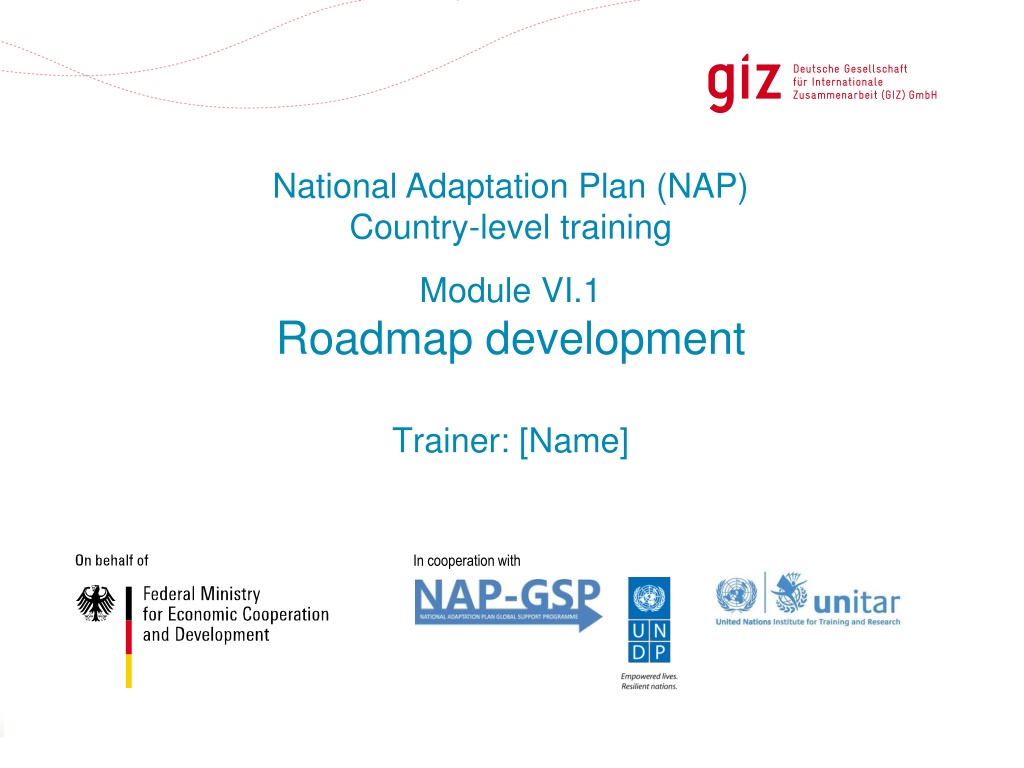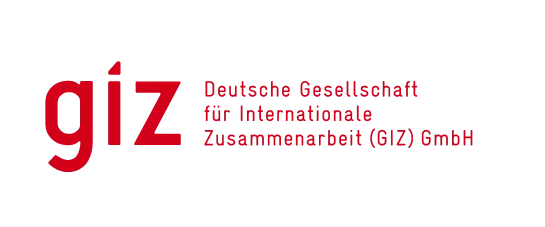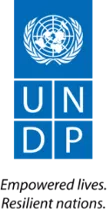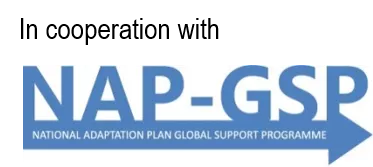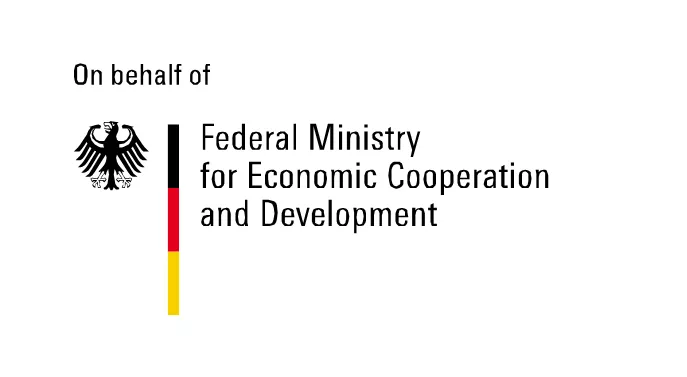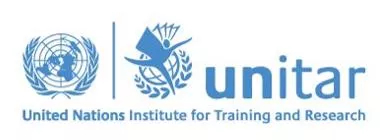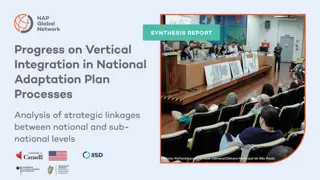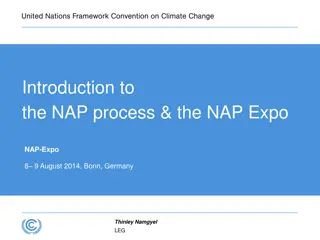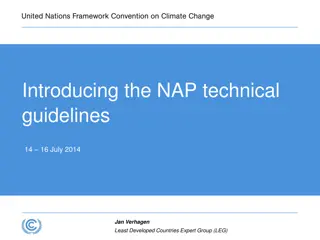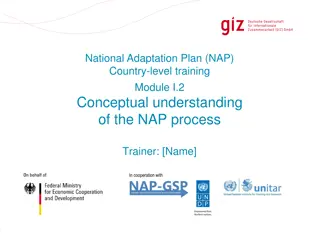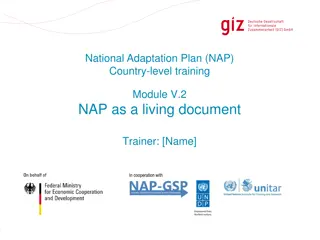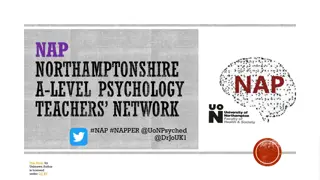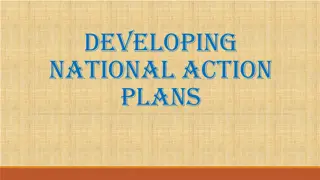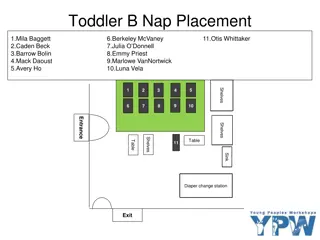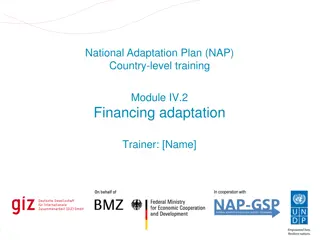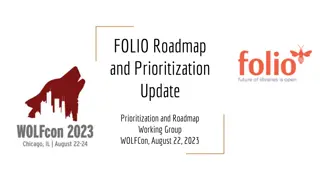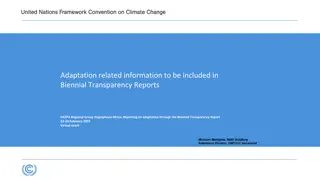National Adaptation Plan (NAP) Coordination and Roadmap Development
This training module focuses on developing a roadmap for the National Adaptation Plan (NAP) process. Participants will learn about coordination structures, examples from different countries, and key elements of roadmaps. The session aims to guide participants in condensing key findings into a consistent roadmap for effective NAP implementation.
Download Presentation

Please find below an Image/Link to download the presentation.
The content on the website is provided AS IS for your information and personal use only. It may not be sold, licensed, or shared on other websites without obtaining consent from the author. Download presentation by click this link. If you encounter any issues during the download, it is possible that the publisher has removed the file from their server.
E N D
Presentation Transcript
National Adaptation Plan (NAP) Country-level training Module VI.1 Roadmap development Trainer: [Name] In cooperation with Slide 1
Overview of this module Building on the results of the previous group work Examples of NAP coordination structures from other countries Examples of NAP roadmaps from other countries Jointly develop a draft roadmap for the NAP process Slide 2
What can you expect to learn from this session? Get to know differences and similarities in coordination structures for national adaptation planning Learn about key elements of roadmaps Understand how to condense key findings of previous steps into a consistent roadmap as guidance for the concrete NAP process Slide 3
What is meant by roadmap? A term to describe a format in which one or several people agree on steps, activities and milestones in order to achieve an objective. There are also other names, e.g. action plan. For NAP, the term refers to the sequencing activities that create and organize the NAP process. Slide 4
Intersectoral coordination: example from Indonesia Source: NAP Expo 2014, Day 1, Session III/ I: Sato Ichiro, Japan. JICA support for climate change adaptation in Indonesia Slide 5
Intersectoral coordination: example from Germany Federal Ministry for the Environment Federal Environment Agency/KomPass Research Institutes NAS- process Working group of all federal ministries Stakeholder (Business, NGO) Conference of the federal states Slide 6
Functional coordination structures Division of labour functional More transparency through close interaction and cooperation In a practical context: inter-institutional panel comprised of experts continuous exchange of knowledge Such interactions provide: exchange of different perspectives and types of knowledge; problem solving skills; power balances among interest groups; policy flexibility. Slide 7
What to consider when developing a roadmap What: Main goals and milestones? What is needed to get there? When: Until when shall goals and milestones be achieved? Who: Who is driving the process? Who is responsible for milestones? Who provides (technical/scientific) assistance? Who implements? Define clear roles and responsibilities Whose resources: Who will make funds available (state budget, national and international climate funds, private sector)? Formulate measures! Consider a follow-up strategy / steps after the roadmap (implementation, revision, etc.) Slide 8
Challenges emerging when developing a roadmap To be elaborated together with participants! Development of different elements / parts of the roadmap in silos Implementation of elements / parts in silos Free-riders Question on financing What else? Slide 9
Workstream suggested by NAP Technical Guidelines on Integrating climate change adaptation into national planning Slide 10
Roadmap skeleton: Step by step analysis What? What does already exist? Main tasks to be conducted to achieve the step Potentially emerging challenges Element Step A A B Initiate / launch NAP Stocktaking Assess vulnerabilities Slide 11
Roadmap skeleton: Focus on activities What? Until when? Who? (main responsible and assistance) Which resources? Element Step A Initiate / launch NAP A Stocktaking B Assess vulnerabilities Other steps / milestones important to your country Slide 12
Roadmap skeleton: Focus on outputs Workstream Specific objectives Activities Responsi- bility Other resources Deadline Comment Planning Implementa- tion Financing Slide 13
Visualize a NAP roadmap for policy makers Workstream I Planning, establishing and stearing the NAP process Workstream II Implementing the NAP process Workstream III Review and learning Time frame Determining capacity needs, setting up M&E system Planning of activities, providing standards and frameworks Short-term (2015) Planning phase Launching the NAP process and drafting roadmap Medium- term (2016- 2018) Implementing cross-sectoral and sectoral activities Monitoring adaptation to climate change Mainstreaming into long-term development planning, budgeting and monitoring systems Long-term (2019 - 2025 and beyond) Bi-annual revision of the roadmap based on M&E Adjustments to the NAP process Slide 14
Exercise step 1: Development of an adequate structure for the roadmap Document the chapters in the first column of matrix VI.1.1 You might get inspiration from the list of exemplary areas for the NAP process as mentioned in chapter 2.1 of the NAP Technical Guidelines Slide 15
Exercise step 2: Identify main tasks to be conducted in your country Identify key tasks under each structure item to be conducted in your county Reflect different issues compiled on the parking lots but also add issues from an overall perspective Revisit the results in Matrix I.3.1, where you developed elements for the work stream Gaps and needs analysis . Identify responsible institutions for the task mentioned in the last column Slide 16
Imprint Published by Deutsche Gesellschaft f r Internationale Zusammenarbeit (GIZ) GmbH This presentation is part of a NAP country-level training that has been developed by GIZ on behalf of BMZ and in cooperation with the NAP Global Support Programme (NAP-GSP), in particular UNDP and UNITAR. Climate Policy Support Project Dag-Hammarskj ld-Weg 1-5 65760 Eschborn, Germany T +49 61 96 79-0 F +49 61 96 79-1115 The training is designed to support countries in setting up a National Adaptation Plan (NAP) process. It builds on the NAP Technical Guidelines developed by the Least- Developed Countries Expert Group (LEG). Contact E climate@giz.de I www.giz.de/climate You are welcome to use the slides, as long as you do not alter its content or design (including the logos), nor this imprint. If you have any questions regarding the training, please contact Till Below or Nele B nner at GIZ. For questions related to the Technical Guidelines, please refer to the UNFCCC s NAP Support Portal. Responsible Nele B nner, GIZ Author Nele B nner Contributions by Stefanie D mig As a federally owned enterprise, the Deutsche Gesellschaft f r Internationale Zusammenarbeit (GIZ) GmbH supports the German Government in achieving its objectives in the field of international cooperation for sustainable development. GIZ also engages in human resource development, advanced training and dialogue. Slide 17
Indicative institutional setup of NAP at national level SDGs High level mandate Gov. Donor Focal Point What we need: Champion, leadership, ownership Sector plan proofing + budgeting (entry points) Focal Point -> initiator SDG NGO, private sector, media Adaptation process DRR (Hyogo) $ POL $ POL $ POL $ POL $ POL $ UNDAF Technical group Steering Committee: Government & Ministries Donor Working Group: Multilateral/bilateral organisations Slide 18
